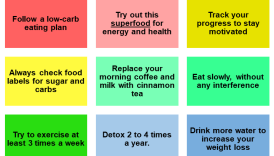How to Maintain a Very Healthy Life: Tips and Tricks

In today’s fast-paced world, prioritizing health can often feel overwhelming. With countless diets, exercise regimens, and wellness trends bombarding us daily, where does one begin? Making the transition to a healthier lifestyle doesn’t have to be daunting. It can be as simple as incorporating small, manageable changes into daily routines. Just like a friend who started cooking at home instead of ordering takeout; she found not only healthier meals but also a newfound passion for culinary arts. So, what does a healthy lifestyle entail? Here are a few foundational elements to consider:
- How to Maintain a Very Healthy Life: Tips and Tricks
- Importance of Maintaining a Healthy Lifestyle
- Key Benefits of a Healthy Lifestyle
- Setting Realistic Health Goals
- Creating SMART Goals
- Nutrition and Balanced Diet
- Healthy Eating Habits
- Importance of Hydration
- Regular Physical Activity
- Types of Exercise for Good Health
- Creating a Fitness Routine
- Quality Sleep and Its Impact on Health
- The Importance of Sleep for Overall Well-Being
- Tips for Improving Sleep Quality
- Managing Stress Levels
- Understanding the Impact of Stress
- Effective Strategies for Stress Management
- Social Connections and Mental Well-being
- The Importance of Social Connections
- Ways to Cultivate and Maintain Relationships
- Preventive Health Screenings and Check-ups
- The Role of Preventive Health Screenings
- Establishing a Routine for Check-ups
- Mental Health and Emotional Wellness
- The Importance of Mental Health
- Strategies for Maintaining Emotional Wellness
- Benefits of Mindfulness and Meditation
- Key Benefits of Mindfulness and Meditation
- Simple Mindfulness Techniques to Try
- Balancing Work and Personal Life
- Why Work-Life Balance Matters
- Strategies for Achieving Work-Life Balance
- Setting Boundaries for Self-care
- The Importance of Setting Boundaries
- Practical Tips for Setting Boundaries**
- Health and Wellness Resources
- Types of Health and Wellness Resources
- Finding Reliable Information
- Conclusion
- Key Takeaways
- Nutrition: Prioritizing fresh, whole foods over processed ones.
- Exercise: Finding enjoyable physical activities that stimulate the body and mind.
- Mental Wellness: Incorporating practices that enhance emotional health and resilience.
By embracing the journey toward a healthier self, individuals can achieve balance and well-being. Let’s explore how to set realistic health goals to kickstart this journey effectively.
Importance of Maintaining a Healthy Lifestyle
Transitioning into a healthier lifestyle goes beyond mere physical appearance; it deeply impacts overall well-being. People often underestimate how daily choices can bolster well-being, enhance mood, and prevent chronic illnesses. For instance, consider a colleague who shifted from a sedentary routine to include brisk walks during lunch breaks. She not only lost weight but also noticed a significant boost in her productivity and happiness!
Key Benefits of a Healthy Lifestyle
Embracing healthy habits can lead to numerous benefits, such as:
- Increased Energy: A balanced diet and regular exercise fuel the body, leading to higher energy levels.
- Enhanced Mood: Physical activity releases endorphins, natural mood lifters that reduce feelings of stress and anxiety.
- Chronic Disease Prevention: A healthy lifestyle lowers the risk of diseases like diabetes, heart disease, and even some cancers.
By committing to maintain a healthy lifestyle, individuals can invest in their future, enjoying a vibrant life full of possibilities. Let’s now delve into how to set realistic health goals that can pave the way for sustainable change.
Setting Realistic Health Goals
Now that the importance of maintaining a healthy lifestyle is clear, the next step is setting achievable health goals. It can be tempting to aim for drastic transformations, but sustainable change often starts with small, realistic steps. A friend of mine decided to run a half-marathon after barely jogging before; while admirable, this daunting goal felt overwhelming and led to burnout instead of progress. Instead, breaking goals into manageable chunks can make all the difference.
Creating SMART Goals
Utilizing the SMART (Specific, Measurable, Achievable, Relevant, Time-bound) framework can help. Here’s how to craft your health goals:
- Specific: Define the goal clearly, e.g., “I want to walk 10,000 steps daily.”
- Measurable: Include metrics, such as weight loss or endurance levels.
- Achievable: Pick something realistic based on your current lifestyle.
- Relevant: Ensure the goal aligns with your values and health priorities.
- Time-bound: Set a deadline to keep you accountable, like “I will reach this goal in 8 weeks.”
Breaking down each goal into actionable steps can motivate progress and maintain enthusiasm. Next, we will explore the significance of nutrition and a balanced diet in achieving these health goals.
Nutrition and Balanced Diet
With clear health goals in place, focusing on nutrition and a balanced diet is crucial for achieving them. Healthy eating isn’t just about restriction; it’s about nourishing the body with the right foods. A friend of mine started meal prepping on Sundays, which transformed her eating habits. She found herself reaching for nutritious snacks and meals instead of junk food. This simple change brought energy and clarity to her days.
Healthy Eating Habits
Establishing healthy eating habits can be easier than it seems. Here are some simple tips to consider:
- Portion Control: Be mindful of portion sizes to avoid overeating.
- Colorful Plate: Aim for a variety of fruits and vegetables, making your meals visually appealing and packed with nutrients.
- Whole Foods: Focus on unprocessed foods like whole grains, lean proteins, and healthy fats.
Importance of Hydration
Alongside nutrition, staying hydrated is essential for overall health. Water supports digestion, joint lubrication, and temperature regulation. Here’s how you can ensure optimal hydration:
- Daily Intake: Aim for at least 8 glasses of water daily.
- Carry a Water Bottle: Keeping a bottle handy can remind you to sip throughout the day.
- Hydrating Foods: Incorporate water-rich fruits and vegetables like cucumbers, oranges, and strawberries into your diet.
Understanding nutrition and hydration sets the foundation for maintaining energy and supporting your fitness journey. Next, we’ll look into regular physical activity and how it complements a healthy diet.
Regular Physical Activity
After establishing strong nutritional habits and staying hydrated, the next essential component of a healthy lifestyle is regular physical activity. Exercise not only enhances overall health but also sharpens mental focus and elevates mood. A colleague of mine recently began incorporating short workouts throughout her day, and she can’t believe the difference it has made in her energy levels. By integrating movement into her daily routine, she rediscovered a joy for fitness she hadn’t experienced before!
Types of Exercise for Good Health
When it comes to physical activity, variety is key. Here are some effective types of exercise to consider:
- Aerobic Exercises: Activities such as walking, jogging, cycling, and swimming improve cardiovascular health.
- Strength Training: Weight lifting or bodyweight exercises like push-ups build muscle and enhance metabolism.
- Flexibility and Balance: Incorporating yoga or Pilates aids in flexibility and injury prevention.
Creating a Fitness Routine
Building a sustainable fitness routine is crucial for long-term success. Here’s a helpful guide:
- Set Realistic Goals: Start small and gradually increase intensity or duration.
- Schedule Workouts: Treat exercise like an appointment in your calendar for better commitment.
- Mix It Up: Combine different types of exercises to keep things engaging.
- Find a Workout Buddy: Having someone to share the journey with makes workouts more enjoyable and keeps you accountable.
By establishing a consistent physical activity routine, individuals can boost their health and feel empowered. Next, we’ll explore the vital role of quality sleep and its impact on overall wellness.
Quality Sleep and Its Impact on Health
As we transition from regular physical activity, it’s critical not to overlook the importance of quality sleep. Sleep is not just a time for rest; it’s when our bodies heal, regenerate, and process information from the day. A friend once shared how her productivity skyrocketed after committing to a consistent sleep schedule. It turned out that quality rest was the missing piece in her quest for improved health.
The Importance of Sleep for Overall Well-Being
Quality sleep plays a vital role in various aspects of health, including:
- Cognitive Function: Adequate sleep sharpens focus and boosts creativity.
- Emotional Health: A well-rested person is better equipped to handle stress and regulate emotions.
- Physical Health: Sleep supports immune function and helps regulate hormones, thereby aiding weight management.
Tips for Improving Sleep Quality
To ensure restorative sleep, consider the following tips:
- Establish a Routine: Go to bed and wake up at the same time every day, even on weekends.
- Create a Relaxing Environment: Keep your bedroom dark, cool, and quiet.
- Limit Screen Time: Avoid electronic devices at least an hour before bed to promote melatonin production.
Improving sleep quality can significantly enhance your overall health, making it an essential focus in your wellness journey. Next, we’ll dive into effective strategies for managing stress levels in our busy lives.
Managing Stress Levels
Following our exploration of quality sleep, it’s vital to address another cornerstone of health: managing stress levels. Stress is an inevitable part of life, but how we handle it can significantly impact our overall well-being. A close friend of mine implemented simple practices to manage stress, such as taking short breaks during her hectic workdays. She found that stepping away to breathe and regroup not only improved her mood but also boosted her productivity.
Understanding the Impact of Stress
Chronic stress can lead to several health issues, including:
- Mental Health Disorders: Increased anxiety and depression risks.
- Physical Symptoms: Headaches, fatigue, or gastrointestinal issues.
- Reduced Immune Function: Increased vulnerability to illness.
Effective Strategies for Stress Management
Here are some practical strategies to effectively manage stress:
- Deep Breathing Exercises: Take a few minutes to breathe deeply, focusing on slow inhales and exhales to calm your mind.
- Mindfulness and Meditation: Practicing mindfulness can help ground you in the present, reducing feelings of anxiety.
- Physical Activity: Regular exercise, such as yoga or a brisk walk, can release endorphins, which act as natural stress relievers.
By actively managing stress, you can foster a healthier mindset and overall well-being. Up next, we’ll look into how social connections and mental well-being play a pivotal role in a fulfilling life.
Social Connections and Mental Well-being
Moving beyond stress management, it’s crucial to recognize the profound impact that social connections have on mental well-being. Strong relationships can provide emotional support, enhance feelings of belonging, and significantly improve overall happiness. A colleague once shared how her weekly coffee catch-ups with friends became her lifeline during challenging times. These simple gatherings not only lifted her spirits but also helped her feel more connected and supported.
The Importance of Social Connections
Healthy relationships can foster resilience and provide multiple mental health benefits, including:
- Reduced Feelings of Loneliness: Engaging with others combats isolation.
- Emotional Support: Friends and family can offer comfort during tough times.
- Increased Happiness: Positive interactions often correlate with higher levels of joy and well-being.
Ways to Cultivate and Maintain Relationships
Here are some effective tips for nurturing social connections:
- Schedule Regular Meet-ups: Make it a habit to connect with friends, whether it’s coffee dates or phone calls.
- Join a Club or Group: Find local activities or hobbies to meet like-minded individuals.
- Be Present: Truly engage in conversations, listen actively, and show appreciation.
By prioritizing social connections, one can enhance their mental well-being and overall quality of life. Next, we’ll delve into the importance of preventive health screenings and regular check-ups in maintaining good health.
Preventive Health Screenings and Check-ups
After discussing the importance of social connections for mental well-being, it’s crucial to shift our focus toward preventive health measures, including screenings and regular check-ups. These proactive steps are essential for catching potential health issues before they escalate. A family member of mine discovered early signs of high blood pressure during a routine check-up, allowing her to make lifestyle changes before any serious health problems arose. This experience highlighted for her—and many others—the significance of preventive care.
The Role of Preventive Health Screenings
Preventive screenings are designed to catch health concerns early, and they can include:
- Blood Pressure Checks: Monitoring hypertension early can prevent cardiovascular disease.
- Cholesterol Screenings: Identifying high cholesterol helps mitigate the risk of heart disease.
- Cancer Screenings: Mammograms, colonoscopies, and skin checks can lead to early diagnosis and treatment.
Establishing a Routine for Check-ups
To make the most of preventive screenings, consider these practices:
- Schedule Annual Check-ups: Regular visits to your healthcare provider can help establish a baseline for your health.
- Stay Informed: Keep track of recommended screenings according to your age and health history.
- Ask Questions: Don’t hesitate to discuss any concerns or symptoms with your healthcare provider during visits.
By prioritizing preventive health screenings, individuals can take charge of their health and potentially avoid serious issues before they arise. Next, we will delve into the essential topic of mental health and emotional wellness.
Mental Health and Emotional Wellness
Following our discussion on preventive health screenings, it’s essential to emphasize mental health and emotional wellness as critical components of overall health. Just like physical health, mental health deserves attention and care. A friend once shared how daily journaling transformed her emotional landscape; it became her safe space to process thoughts and feelings, leading to a greater sense of clarity and peace.
The Importance of Mental Health
Prioritizing mental health can lead to numerous benefits, such as:
- Improved Resilience: A healthy state of mind enhances our ability to cope with stress.
- Better Relationships: Emotional wellness fosters healthier interactions with others.
- Increased Productivity: A clear and focused mindset can boost performance at work or in daily tasks.
Strategies for Maintaining Emotional Wellness
Here are effective strategies to nurture mental health and emotional well-being:
- Practice Self-care: Set aside time for activities that bring you joy and relaxation, like reading or gardening.
- Seek Support: Don’t hesitate to reach out to friends, family, or professionals when feeling overwhelmed.
- Stay Active: Regular physical activity has profound mental health benefits, so incorporate moving into your daily routine.
By prioritizing mental health and emotional wellness, individuals can create a more balanced and fulfilling life. Next, we will explore the benefits of mindfulness and meditation in enhancing overall health.
Benefits of Mindfulness and Meditation
As we transition from the significance of mental health and emotional wellness, it’s important to highlight mindfulness and meditation as powerful tools for enhancing overall well-being. These practices encourage individuals to remain present, reduce stress, and enhance emotional regulation. A friend of mine started meditating for just five minutes a day and found it significantly calmed her racing mind, helping her manage anxiety more effectively.
Key Benefits of Mindfulness and Meditation
Incorporating mindfulness and meditation into daily life can yield numerous advantages, including:
- Stress Reduction: Regular practice helps reduce cortisol levels, the hormone linked to stress.
- Enhanced Focus: Mindfulness improves concentration and cognitive clarity by training the mind to stay present.
- Emotional Regulation: Practicing mindfulness can lead to better management of emotions, reducing reactivity in stressful situations.
Simple Mindfulness Techniques to Try
Here are a few straightforward techniques to incorporate mindfulness into your daily routine:
- Breath Awareness: Spend a few minutes focusing on your breath, noticing each inhale and exhale.
- Body Scanning: Pay attention to different parts of your body, acknowledging any tension and consciously relaxing that area.
- Gratitude Journaling: Take a moment each day to write down things you’re thankful for, fostering a positive mindset.
By adopting mindfulness and meditation, individuals can cultivate a greater sense of peace and resilience. Up next, we’ll discuss the importance of balancing work and personal life.
Balancing Work and Personal Life
As we shift from the benefits of mindfulness and meditation, it becomes clear that achieving a harmonious balance between work and personal life is essential for overall wellness. In our busy world, it’s easy to let work consume our time and energy at the expense of personal relationships and self-care. A colleague once shared how she struggled to set boundaries between her work and home life, leading to stress and burnout. However, after implementing small changes, she found her productivity improved along with her well-being.
Why Work-Life Balance Matters
Maintaining a balance between work and personal life has important benefits, including:
- Reduced Stress: Proper boundaries help mitigate the feeling of being overwhelmed.
- Improved Relationships: Time spent with family and friends enhances emotional connections and support systems.
- Enhanced Productivity: A balanced life leads to greater focus and efficiency during work hours.
Strategies for Achieving Work-Life Balance
Consider these actionable strategies to help foster balance in your life:
- Set Clear Boundaries: Define specific work hours, and communicate them to colleagues and supervisors.
- Schedule Personal Time: Treat personal plans with the same importance as work meetings, ensuring you dedicate time to yourself and loved ones.
- Unplug After Hours: Limit email and work-related notifications during personal time to fully engage in relaxation and leisure activities.
By actively pursuing work-life balance, individuals can cultivate a life that prioritizes both professional aspirations and personal fulfillment. Next, we’ll explore the importance of setting boundaries for self-care and its impact on overall health.
Setting Boundaries for Self-care
Continuing from our discussion on balancing work and personal life, setting boundaries for self-care is a critical aspect of maintaining overall health and well-being. Many people, myself included in the past, often struggle to put their needs first, leading to exhaustion and diminished productivity. A friend of mine realized that saying “no” sometimes was essential to preserving her mental health and ensuring she had time for herself. This realization transformed her daily routine and improved her overall outlook.
The Importance of Setting Boundaries
Establishing boundaries is fundamental for several reasons:
- Prevention of Burnout: Clearly defined limits help guard against emotional and physical exhaustion.
- Prioritizes Personal Needs: Setting aside time for self-care ensures that individual well-being is not neglected.
- Improves Relationships: Healthy boundaries can lead to better interactions with others, as they respect your needs.
Practical Tips for Setting Boundaries**
Here are some practical suggestions for establishing boundaries that support self-care:
- Identify Your Limits: Reflect on what drains your energy and where you feel overwhelmed; use this insight to set specific limits.
- Communicate Clearly: Let others know your boundaries in a respectful manner—whether it’s family, friends, or colleagues.
- Schedule Self-Care: Treat self-care activities as essential appointments on your calendar to ensure they are prioritized.
By actively setting boundaries for self-care, individuals can create space for rejuvenation and peace amidst the demands of daily life. Next, we’ll explore valuable health and wellness resources that can further support this journey.
Health and Wellness Resources
Building on the importance of setting boundaries for self-care, it’s crucial to utilize health and wellness resources that support your journey. With so much information available, having reliable resources can help streamline your path toward better health. A family member of mine discovered an online community focused on wellness, which not only provided valuable information but also connected her with individuals sharing similar goals. This made her feel less isolated on her journey, encouraging her to make significant lifestyle changes.
Types of Health and Wellness Resources
Here are some excellent resources to consider incorporating into your health regimen:
- Online Courses and Workshops: Platforms like Coursera and Udemy offer courses on nutrition, mindfulness, and fitness practices.
- Mobile Apps: Apps like MyFitnessPal, Headspace, or Calm can assist with tracking diet, exercise, and mindfulness practice.
- Local Community Centers: Check for classes or support groups related to health and fitness in your local area.
Finding Reliable Information
When seeking health information, consider these tips:
- Consult Reputable Websites: Look for information from trustworthy sources such as the CDC, WHO, or registered health professionals.
- Read Reviews and Testimonials: Research user experiences to determine the effectiveness of wellness programs or products.
- Engage with Professionals: Don’t hesitate to consult healthcare providers or wellness coaches for personalized advice.
By leveraging these resources, you can create a comprehensive support system that enhances your health and well-being journey. Lastly, let’s wrap up our discussion with a thoughtful conclusion that summarizes key takeaways.
Conclusion
As we conclude this exploration of health and wellness, it’s clear that achieving a balanced lifestyle involves a multifaceted approach. From setting realistic health goals and establishing healthy eating habits to managing stress and prioritizing self-care, each aspect contributes to overall well-being. A dear friend summarized it best when she said, “Success in health is not about perfection; it’s about progress.”
Key Takeaways
To reinforce the main points discussed, remember to:
- Prioritize Nutrition and Physical Activity: Together they create a robust foundation for health.
- Value Sleep and Stress Management: Both are essential for mental and emotional well-being.
- Engage Socially and Seek Resources: Leverage community support and reliable tools for guidance.
By taking small, actionable steps, individuals can pave the way to a healthier, more fulfilling life. Embrace the journey and celebrate every achievement, no matter how small!




